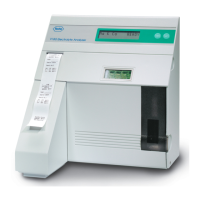Roche Diagnostics
40 Instructions for Use · Version 10.0
3 Specifications 9180 Electrolyte Analyzer
Interferences
Interferences
Salicylate, in extremely high levels, is known to interfere with the chloride electrode
and results in a positive bias of the chloride result. At therapeutic levels of salicylate
concentration, the influence on chloride is clinically insignificant.
The lithium electrode shows a slight sensitivity to the calcium present in the sample
and results in a negative bias of the lithium result. At normal physiological calcium
concentrations, the influence of calcium is clinically insignificant.
WARNING
Using sample containers with lithium anticoagulant may lead to incorrect Li
+
measurements
Using sample containers with lithium as an anticoagulant may lead to incorrect QC
measurements and/or incorrect patient results for Li
+
, which may endanger patient lives.
r If you use the analyzer to determine Li
+
results, use lithium-free sample containers.
u Interference (p. 97)
Limitations
A number of substances have been reported to cause physiological changes in blood,
serum and plasma analyte concentrations. No significant effect on serum has been
demonstrated from bromide, ammonium and iodide.
As with any clinical reaction, users should know the possible effect on results due to
unknown interference from medications or endogenous substances. All patient
results have to be evaluated by the laboratory and the physician in light of the total
clinical status of the patient.
Opening and closing the fist with a tourniquet results in an increase in potassium
levels by as much as 10 to 20%. It is recommended that the blood sample is obtained
without a tourniquet, or that the tourniquet be released after the needle has entered
the vein and 2 minutes has elapsed before the sample is withdrawn.
Since the concentration of potassium inside erythrocytes is much greater than that in
extracellular fluid, hemolysis should be avoided, and the serum should be separated
from the cells immediately after collection.
The lithium electrode response is dependent on the actual sodium concentration of
the sample. The lithium result can only be calculated for a Na
+
range of
89.6 - 169.5 mmol/L in serum and plasma samples and for a Na
+
range of
95 - 180 mmol/L in QC materials and Standard solutions.
Chloride values lower than 60 mmol/L must be confirmed with a central laboratory
measurement.
Non-physiologically low Ca
2+
values (e. g. during citrate hemofiltration) must not be
used for therapeutic decisions.

